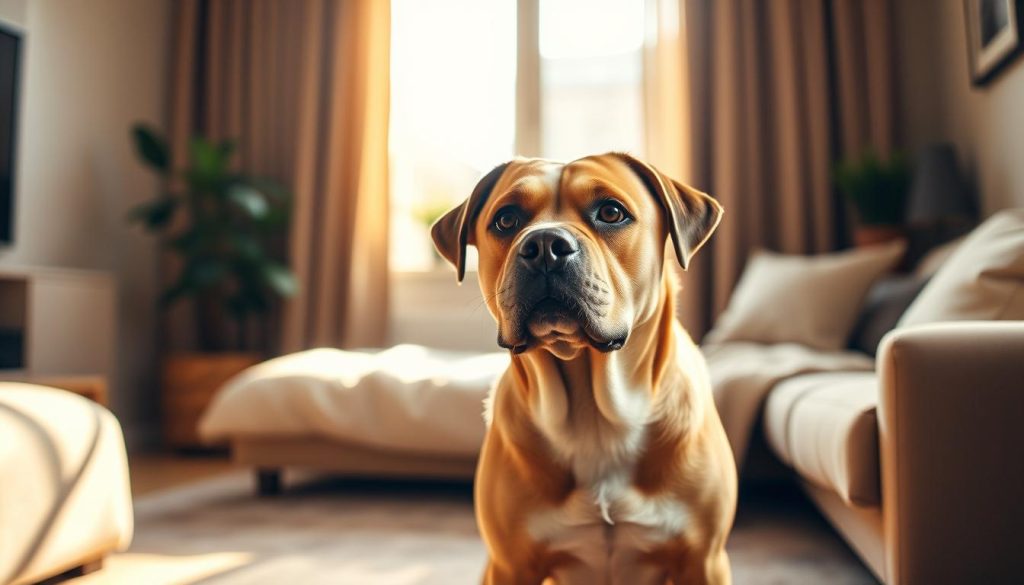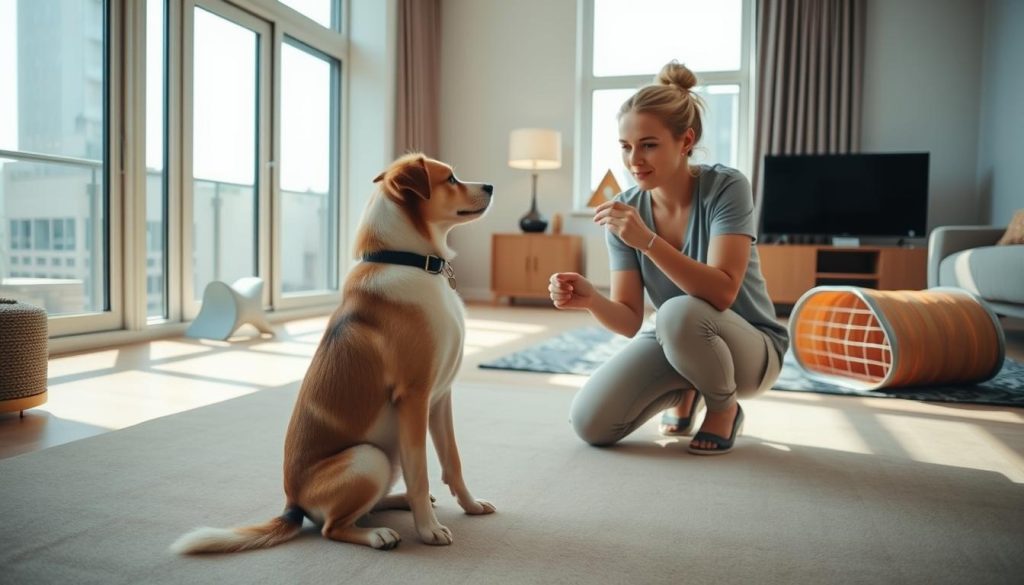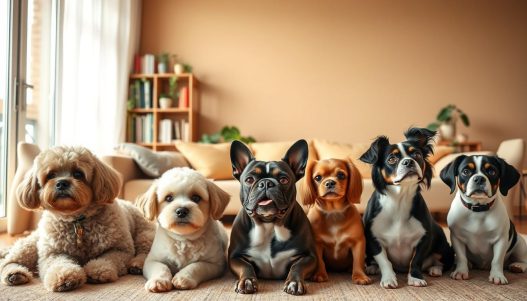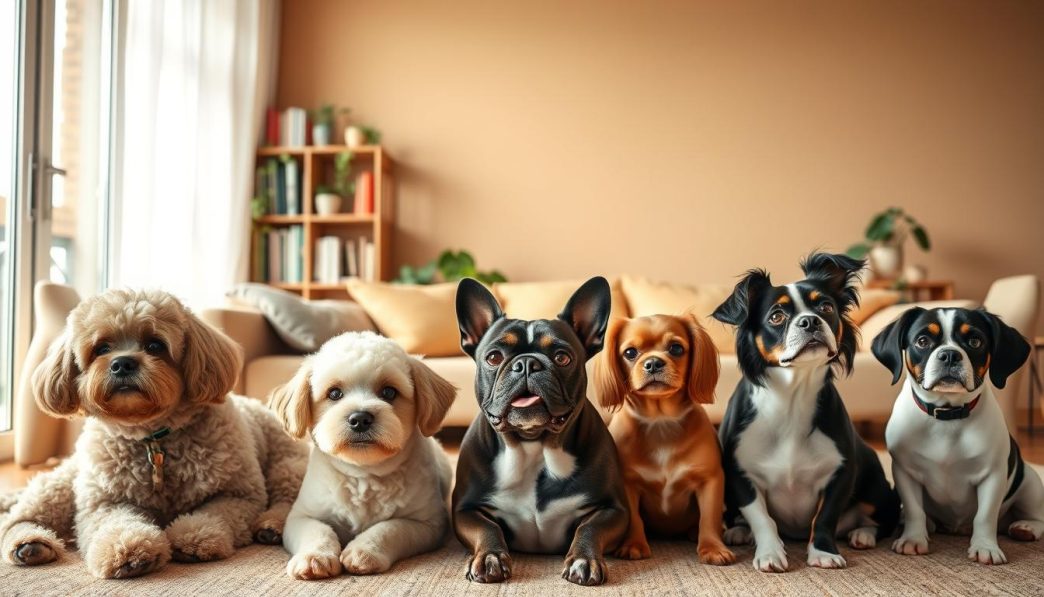Finding the right apartment-friendly dog breeds can be a challenge. Living in an apartment doesn’t mean you can’t enjoy the companionship of a furry friend. The key is to choose a breed that fits your lifestyle and living situation.
When selecting a dog breed for small spaces, consider factors such as size, temperament, and exercise needs. Some breeds are naturally more suited to apartment living due to their calm nature and minimal exercise requirements.
We’ll explore the characteristics that make a breed suitable for apartment living and introduce you to some of the best dog breeds for apartments. Whether you’re a seasoned dog owner or a first-time pet parent, this guide will help you find the perfect companion.
Key Takeaways
- Size, temperament, and exercise needs are crucial factors in choosing an apartment-friendly dog breed.
- Some dog breeds are naturally more suited to apartment living due to their calm nature.
- Minimal exercise requirements are a key characteristic of apartment-friendly breeds.
- Researching the right breed can help you find a great companion for apartment living.
- Apartment-friendly dog breeds can thrive in small spaces with proper care and attention.
What Makes a Good Apartment Dog
The key to a happy apartment dog lies in understanding the characteristics that make a breed thrive in smaller spaces. While size is often considered, it’s not the only factor. Other crucial elements include the dog’s energy level, barking tendency, and exercise needs.
Beyond Size: Key Characteristics
A good apartment dog typically has a calm temperament, being neither too aggressive nor too anxious. Low-shedding coats can also be beneficial, especially for those with allergies. Additionally, dogs that are adaptable and don’t require a large yard can thrive in apartments. Breeds with low exercise needs or those that are content with indoor activities are particularly well-suited.
Balancing Exercise Needs with Limited Space
Even if a dog doesn’t need a large yard, it still requires regular exercise to stay healthy and happy. Indoor activities such as hide-and-seek, stair climbing, or interactive toys can help meet these needs. For dogs that require more physical activity, short walks or visits to dog parks can provide the necessary outlet. It’s about finding a balance that works for both you and your dog.
Best Dog Breeds for Apartment Living
Selecting the best dog breed for apartment living involves more than just considering the size of the dog; it’s about finding a breed that fits your lifestyle. When living in an apartment, factors such as exercise needs, noise levels, and temperament become crucial in determining the suitability of a breed.
Selection Criteria for Our Recommendations
Our selection criteria for the best dog breeds for apartments include temperament, energy level, and size. We also consider the dog’s need for exercise and training, as well as its tendency to bark or make other noise.
- Temperament: A calm and even-tempered dog is less likely to cause issues in an apartment setting.
- Energy Level: Dogs with low to moderate energy levels are generally more suitable for apartment living.
- Size: While not the only factor, size can be an important consideration, especially in very small apartments.
Adapting to Your Specific Apartment Situation
Adapting a dog to apartment living requires understanding your specific situation, including the size of your apartment, your work schedule, and your ability to provide exercise and training. For instance, if you have a busy schedule, a low-maintenance breed might be more suitable.
The Importance of Temperament Over Size
While size is often considered when choosing a dog for apartment living, temperament is far more important. A dog with a calm temperament is less likely to bark excessively or cause disturbances, making it a better fit for apartment living.
| Breed | Temperament | Energy Level |
|---|---|---|
| French Bulldog | Calm, affectionate | Low |
| Boston Terrier | Friendly, outgoing | Moderate |
| Shih Tzu | Outgoing, loyal | Low |
Small Breed Superstars for Apartments
Apartment living doesn’t mean you have to sacrifice the joy of having a dog; several small breeds thrive in smaller environments. These breeds are not only adorable but also have characteristics that make them ideal for apartment living.
French Bulldog
The French Bulldog is a popular choice for apartment dwellers due to its calm and laid-back nature. They are relatively low maintenance compared to other breeds.
Exercise Needs and Noise Level
French Bulldogs have moderate exercise needs; short walks and playtime suffice. They are also known for being relatively quiet, making them a good fit for apartments.
Personality Traits and Adaptability
They are affectionate, adaptable, and can thrive in various living situations. Their laid-back nature makes them an excellent choice for apartment living.
Shih Tzu
The Shih Tzu is another breed that excels in apartment environments. They are friendly, outgoing, and loyal companions.
Exercise Needs and Noise Level
Shih Tzus require daily walks but are generally low maintenance in terms of exercise. They can be prone to barking, so training is essential.
Personality Traits and Adaptability
Shih Tzus are known for their friendly and outgoing personalities. They adapt well to apartment living due to their calm nature.
Bichon Frise
Bichon Frises are small, fluffy dogs that are perfect for apartment living due to their gentle and playful nature.
Exercise Needs and Noise Level
They require regular grooming but are relatively low maintenance in terms of exercise. Bichon Frises can be sensitive to noise, so a quiet environment is beneficial.
Personality Traits and Adaptability
Bichon Frises are friendly, adaptable, and great companions. They are well-suited for apartment living due to their gentle nature.
When choosing a breed, it’s essential to consider factors such as exercise needs, noise level, and personality traits to ensure compatibility with your lifestyle.
| Breed | Exercise Needs | Noise Level | Personality Traits |
|---|---|---|---|
| French Bulldog | Moderate | Low | Affectionate, Adaptable |
| Shih Tzu | Low | Moderate | Friendly, Outgoing |
| Bichon Frise | Low | Low | Gentle, Playful |
Medium-Sized Dogs That Excel in Apartments
For those who prefer a medium-sized dog, several breeds stand out as being particularly well-suited to apartment living due to their temperament and adaptability. While they may require a bit more space than smaller breeds, with the right care, they can thrive in an apartment setting.
Basset Hound
The Basset Hound is a calm and gentle breed that can adapt well to apartment living. They are not overly demanding in terms of exercise, which makes them a good fit for a more sedentary lifestyle.
Exercise Needs and Noise Level
Basset Hounds need regular, short walks to stay healthy. They are relatively quiet, with occasional barking, making them suitable for apartment environments where noise needs to be kept to a minimum.
Personality Traits and Adaptability
Basset Hounds are known for their friendly and outgoing personalities. They are relatively easy-going and can adapt to a variety of living situations, including apartments, as long as they receive proper care and attention.
Boston Terrier
Boston Terriers are known for their affectionate and friendly nature, making them excellent companions for apartment dwellers. They are relatively small in size but have a big personality.
Exercise Needs and Noise Level
They require moderate exercise, such as short walks and playtime. Boston Terriers are generally quiet, with a low tendency to bark excessively, which is ideal for apartment living.
Personality Traits and Adaptability
Boston Terriers are highly adaptable and known for their gentle, even-tempered nature. They form strong bonds with their owners and are relatively easy to train.
Whippet
Whippets are sleek, athletic dogs that might seem like an unusual choice for apartment living. However, they are quiet and laid-back, making them a viable option.
Exercise Needs and Noise Level
Despite their athletic ability, Whippets are not high-energy dogs and can get sufficient exercise through short, regular sessions. They are quiet and do not bark much, making them suitable for apartments.
Personality Traits and Adaptability
Whippets are known for their calm and affectionate nature. They are adaptable to living in apartments as long as they have a comfortable space to rest and regular opportunities for short bursts of exercise.
| Breed | Exercise Needs | Noise Level | Adaptability |
|---|---|---|---|
| Basset Hound | Short, regular walks | Low to moderate | High |
| Boston Terrier | Moderate | Low | High |
| Whippet | Short, regular exercise | Low | High |

Larger Breeds That Surprisingly Thrive in Apartments
Contrary to popular belief, certain larger dog breeds can thrive in apartment environments, provided their needs are met. These breeds often surprise owners with their adaptability and gentle nature.
Greyhound
Greyhounds are known for their calm demeanor, making them a great choice for apartment living. Despite their large size, they are relatively low-maintenance in terms of exercise.
Exercise Needs and Noise Level
Greyhounds require regular exercise but are not overly demanding. They are quiet dogs and do not bark frequently, which is a plus for apartment dwellers.
Personality Traits and Adaptability
Greyhounds are affectionate and laid-back. They adapt well to apartment living due to their quiet nature and relatively low exercise needs.
Great Dane
Great Danes are another breed that can thrive in apartments, thanks to their gentle giant reputation. They are friendly and patient, making them a great companion.
Exercise Needs and Noise Level
While Great Danes need regular exercise, they don’t require as much as one might think. They can be quite quiet, though occasional barking is possible.
Personality Traits and Adaptability
Great Danes are known for being friendly and gentle. Their calm nature helps them adapt to apartment living, despite their large size.
Bullmastiff
Bullmastiffs are powerful dogs with a calm and gentle disposition, making them suitable for apartment living if properly cared for.
Exercise Needs and Noise Level
Bullmastiffs need regular exercise to stay healthy. They are generally quiet, but their size and occasional barking can be a consideration in an apartment.
Personality Traits and Adaptability
Bullmastiffs are loyal and loving. They can adapt to apartment living due to their calm nature, but they do require adequate space and exercise.
| Breed | Exercise Needs | Noise Level | Adaptability |
|---|---|---|---|
| Greyhound | Moderate | Low | High |
| Great Dane | Moderate | Low-Moderate | High |
| Bullmastiff | Moderate-High | Low-Moderate | Moderate |
Hypoallergenic Options for Apartment Dwellers
For individuals with allergies, finding the right dog breed for apartment living can be challenging, but hypoallergenic breeds offer a solution. These breeds are known for producing fewer allergens than other dogs, making them ideal for apartment dwellers who suffer from allergies.
Maltese
The Maltese is a small, affectionate dog that is considered hypoallergenic due to its low-shedding coat. This breed requires regular grooming to prevent matting.
Exercise Needs and Noise Level
Maltese dogs have moderate exercise needs and are generally quiet, making them suitable for apartment living.
Personality Traits and Adaptability
Maltese are known for being gentle and adaptable. They thrive on human companionship and can be quite playful.
Miniature Schnauzer
The Miniature Schnauzer is a robust and intelligent breed with a hypoallergenic coat. Their double coat requires regular grooming.
Exercise Needs and Noise Level
Miniature Schnauzers are energetic and require regular exercise. They can be prone to barking, so training is essential.
Personality Traits and Adaptability
Miniature Schnauzers are loyal and friendly. They are generally good with children and other pets if socialized properly.
Yorkshire Terrier
The Yorkshire Terrier, or Yorkie, is a spunky and affectionate breed with a hypoallergenic coat. They require regular grooming to keep their coat in check.
Exercise Needs and Noise Level
Yorkies have moderate exercise needs and can be quite vocal, so they require training to manage barking.
Personality Traits and Adaptability
Yorkies are known for their big personalities. They are adaptable to apartment living but require attention and interaction.
As
“The right dog can bring immense joy to our lives, and for those with allergies, hypoallergenic breeds are a great option.”
By choosing a hypoallergenic breed like the Maltese, Miniature Schnauzer, or Yorkshire Terrier, apartment dwellers with allergies can enjoy the companionship of a dog without exacerbating their allergies.
Low-Energy Breeds for Busy Urban Lifestyles
Low-energy dog breeds are perfect for urban dwellers who want a pet that fits into their busy schedule. These breeds are not only adaptable to apartment living but also require less exercise, making them ideal for city residents with limited outdoor space.
Cavalier King Charles Spaniel
The Cavalier King Charles Spaniel is a friendly and affectionate breed that thrives on human companionship. They are relatively small in size and have a moderate energy level, requiring daily walks but not excessive exercise.
Exercise Needs and Noise Level
They need regular walks but are not high-energy dogs. They are generally quiet and not prone to excessive barking, making them suitable for apartment living.
Personality Traits and Adaptability
Cavalier King Charles Spaniels are known for their gentle and friendly nature. They adapt well to urban living due to their calm demeanor and are great companions for those who want a low-maintenance yet loving pet.
Pug
Pugs are small, playful dogs with a lot of personality. They are loyal and loving, making great companions for city dwellers.
Exercise Needs and Noise Level
Pugs require moderate exercise, such as short walks and playtime. They can be prone to snoring and may bark to alert their owners, but they are generally quiet.
Personality Traits and Adaptability
Pugs are known for their playful and affectionate nature. They are adaptable to apartment living due to their small size and can thrive in urban environments with proper care.
English Bulldog
English Bulldogs are sturdy and compact dogs with a calm demeanor. They are ideal for urban living due to their low-energy requirements.
Exercise Needs and Noise Level
They require minimal exercise, such as short walks. English Bulldogs can be prone to snoring and may make other noises due to their brachycephalic nature, but they are generally not loud.
Personality Traits and Adaptability
English Bulldogs are known for their gentle and laid-back nature. They are adaptable to urban living and can make great pets for those who want a low-maintenance companion.
| Breed | Exercise Needs | Noise Level | Adaptability |
|---|---|---|---|
| Cavalier King Charles Spaniel | Moderate | Low | High |
| Pug | Moderate | Moderate | High |
| English Bulldog | Low | Low | High |
Training Essentials for Apartment Dogs
Training apartment dogs requires a tailored approach, focusing on key areas such as potty training and noise management. Apartment living presents unique challenges, including limited space and close proximity to neighbors, making effective training crucial.
Potty Training Strategies for Limited Outdoor Access
Potty training is a significant challenge for apartment dogs due to limited outdoor access. Establishing a routine is vital. Take your dog outside at the same times each day, such as first thing in the morning and after meals. Consistency helps your dog learn when it’s time to go. For apartments with limited outdoor access, consider using puppy pads or indoor potty solutions as an alternative.
- Identify a specific area for your dog to use as their “bathroom.”
- Use positive reinforcement, such as treats and praise, when your dog uses the designated area correctly.
- Watch for signs that your dog needs to go, such as sniffing or circling.
Noise Control and Barking Management
Noise control is another critical aspect of training apartment dogs. Excessive barking can be a significant issue, disturbing neighbors and causing tension. To manage barking, it’s essential to understand the cause. Common triggers include boredom, anxiety, and external stimuli.
- Identify the cause of your dog’s barking.
- Use positive reinforcement training to teach your dog the “quiet” command.
- Provide adequate exercise and mental stimulation to reduce barking caused by boredom or excess energy.

Creating a Dog-Friendly Apartment Environment
To make the most of apartment living with dogs, it’s essential to adopt strategies that maximize space and minimize boredom. Creating a dog-friendly environment involves more than just providing a comfortable place for your dog to rest; it’s about crafting a space that promotes their physical and mental well-being.
Space Optimization Techniques
Optimizing your apartment’s space for your dog involves selecting multi-functional furniture and creating designated areas for your dog’s activities. Consider using storage bins for toys and supplies, and invest in a comfortable dog bed that fits well in a quiet corner of your home.
Here are some space-saving tips:
- Use wall-mounted shelves for dog supplies.
- Choose a compact dog crate that fits under a table or against a wall.
- Select a dog bed that doubles as a sofa or chair.
Indoor Exercise Solutions and Mental Stimulation
Indoor exercises and mental stimulation activities are crucial for dogs living in apartments. Engage your dog in play with interactive toys, and consider setting up an indoor obstacle course using household items.
| Activity | Description | Benefits |
|---|---|---|
| Hide and Seek | Hide treats or toys around the apartment. | Mental stimulation, encourages exploration. |
| Indoor Fetch | Throw a ball or toy down a hallway or room. | Physical exercise, improves retrieval skills. |
| Stair Climbing | For multi-story apartments, guide your dog up and down stairs. | Physical exercise, improves cardiovascular health. |
By implementing these strategies, you can create a dog-friendly apartment environment that supports your dog’s overall health and happiness.
Navigating Apartment Living Challenges with Dogs
Apartment living with dogs requires careful consideration of several factors to ensure a harmonious living environment. While having a dog can be incredibly rewarding, it also presents unique challenges, particularly in apartment settings.
Building Relationships with Neighbors
One of the key challenges of apartment living with dogs is building and maintaining good relationships with your neighbors. This can be achieved by being considerate of noise levels and ensuring your dog is well-behaved. Training your dog to respond to quiet commands and minimizing barking can significantly improve your relationship with those around you.
Being a responsible dog owner in an apartment complex also means being mindful of common areas and respecting shared spaces. By doing so, you can foster a positive living environment for both you and your neighbors.
Managing Separation Anxiety in Small Spaces
Dogs living in apartments can sometimes suffer from separation anxiety due to the close proximity of neighbors and the potential for noise disturbances. To manage this, it’s essential to gradually acclimate your dog to being alone and provide adequate mental stimulation and exercise.
Creating a comfortable and safe space for your dog can also help alleviate separation anxiety. This can include providing familiar comforts like a favorite toy or blanket, and ensuring your dog has enough physical and mental stimulation before you leave the apartment.
Breed-Specific Considerations for Apartment Rules
When it comes to apartment living with dogs, understanding breed-specific considerations is crucial. Certain breeds may be subject to specific rules and regulations in rental properties, and being aware of these can help dog owners navigate potential challenges.
Navigating Breed Restrictions in Rental Properties
Breed restrictions are a common issue in many apartment complexes. Some landlords or property managers may have specific rules against certain breeds, so it’s essential to check your lease agreement before bringing a dog into your apartment.
To navigate these restrictions, dog owners can take several steps:
- Research the breed restrictions in your apartment complex before adopting a dog.
- Review your lease agreement carefully to understand any breed-specific rules.
- Consider discussing your options with your landlord or property manager if you’re unsure about your dog’s breed.
| Breed | Common Restrictions | Potential Solutions |
|---|---|---|
| Large Breeds (e.g., Great Dane) | Size restrictions, potential damage concerns | Discuss size accommodations with landlord, consider pet insurance |
| High-Energy Breeds (e.g., Border Collie) | Noise concerns, exercise needs | Implement training to reduce noise, provide regular exercise |
Insurance Considerations for Certain Breeds
Some dog breeds are considered higher risk by insurance companies, which can impact your ability to secure renters insurance or increase your premiums. Understanding these insurance considerations is vital for dog owners in apartments.
Dog owners can mitigate insurance concerns by:
- Researching insurance providers that cover their dog’s breed.
- Providing training and behavioral documentation for their dog.
- Considering liability insurance to cover potential risks.
Conclusion
Finding the ideal dog breed for apartment living is a multifaceted decision that involves considering factors such as size, temperament, and exercise needs. By selecting a breed that aligns with your lifestyle and living situation, you can enjoy a fulfilling companionship with your dog, even in a limited space.
The best dog breeds for apartment living are those that adapt well to indoor environments and have temperaments that suit the close quarters of apartment living. Whether you opt for a small breed like the French Bulldog or a larger breed like the Greyhound, understanding their needs is crucial.
Apartment living with dogs requires careful consideration of their exercise and mental stimulation needs. By providing the right balance, you can ensure your dog leads a happy and healthy life. With the right breed and proper care, apartment living with dogs can be a truly rewarding experience.






